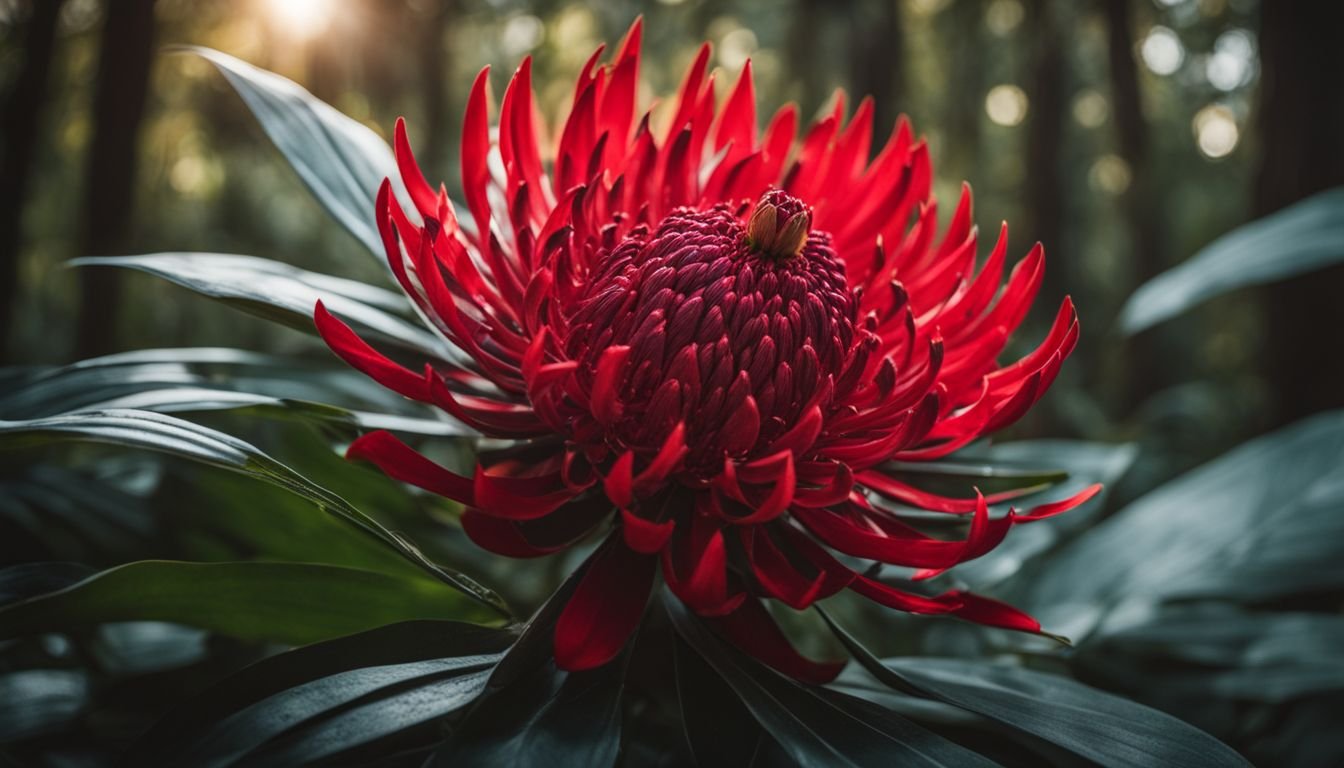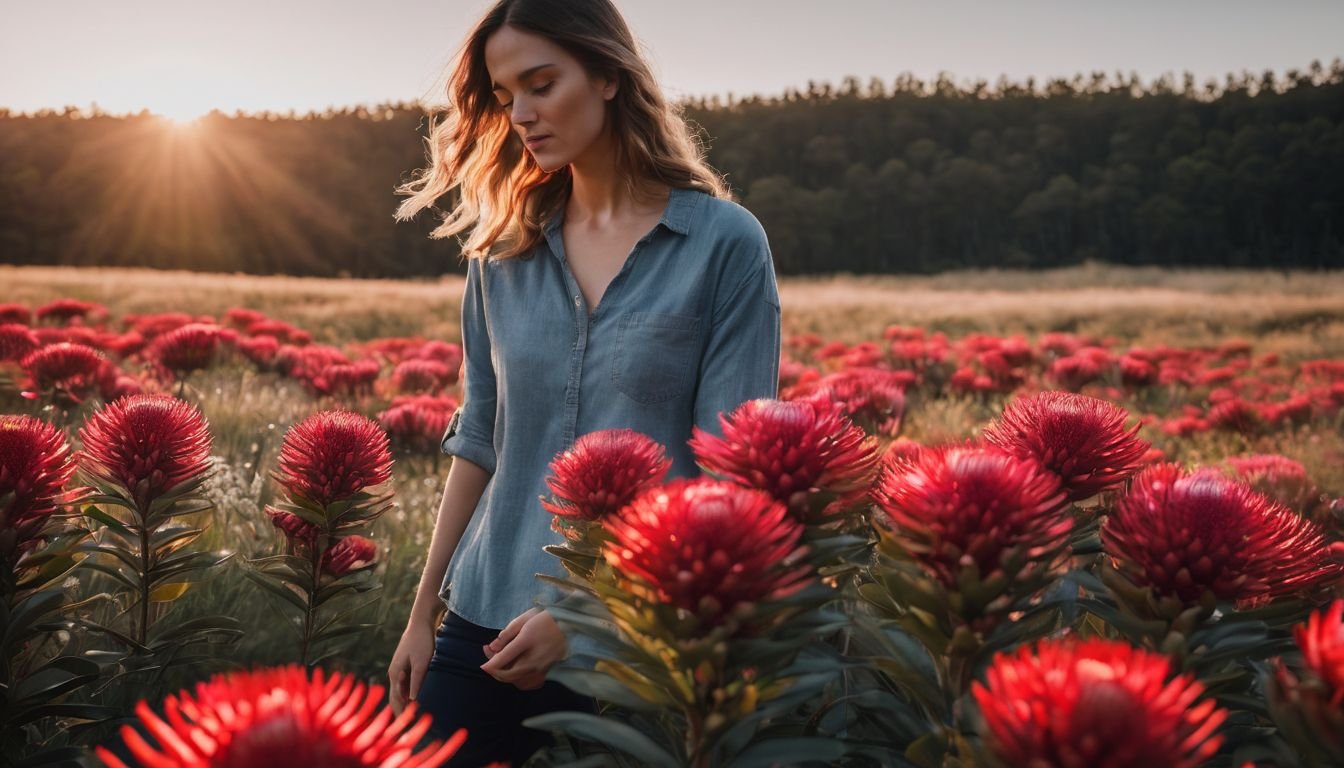Growing the perfect garden means embracing the unique flora native to your homeland. The waratah flower, with its stunning crimson petals and rich heritage, stands as one of Australia’s most magnificent blooms.
This article will guide you through understanding the beauty and history of this spectacular flower and provide essential tips for cultivating it in your own garden space. Discover why the waratah is not just a plant but a symbol etched in Australian culture—read on!
Key Takeaways
- Waratahs are a striking part of Australia’s native flora, with varieties like the New South Wales Waratah and Wirrimbirra White being highly prized by gardeners.
- The New South Wales Waratah is not only known for its beauty but also as a symbol of resilience in Australian culture, reflecting stories from Aboriginal Dreamtime.
- Growing waratahs requires specific conditions such as well – drained sandy soil with slight acidity and protection from harsh afternoon sun.
- Although the Golden Wattle became Australia’s national floral emblem, waratahs continue to hold significant cultural importance and inspire artists within the country.
- Proper care for waratah plants includes ensuring adequate sunlight with some shade, regular watering during dry spells, annual pruning after flowering, and watching out for pests.
About the Waratah Flower

Delve into the fascinating realm of the Waratah, a captivating floral icon that embodies Australia’s rugged beauty and botanical diversity. Explore its intriguing varieties, including the celebrated New South Wales Waratah, each telling its own story through vibrant hues and intricate forms.
Varieties of Waratah
Australia boasts a stunning array of Waratah species, each with unique characteristics that delight gardeners and nature enthusiasts alike. From the iconic New South Wales Waratah to its rarer counterparts, these flowers not only add splendor to gardens but also play a role in Australia’s botanical heritage.
- New South Wales Waratah (Telopea speciosissima): Often seen as the poster child for waratahs, this species features large, vivid red flowers that can transform any garden into a showcase of natural beauty. Known for its terminal flowers which sit at the apex of branches, T. speciosissima has become an emblematic image across New South Wales.
- Wirrimbirra White: A rare variation of Telopea speciosissima, this white waratah is a true gem among plant collectors. The Wirrimbirra White stands out with its creamy bracts surrounding a cluster of greenish florets, offering an elegant contrast to the common red varieties.
- Gibraltar Range Waratah (Telopea aspera): This species thrives in the wild landscapes of northern New South Wales. With striking spiky bracts and smaller flower clusters, T. aspera adds texture and interest to diverse garden settings.
- Monga Waratah (Telopea mongaensis): Found in the forests of southern New South Wales and eastern Victoria, T. mongaensis is admired for its deep pink blooms. The Monga waratah brings resilience and color to gardens even in nutrient-poor soils.
- Victorian Waratah (Telopea oreades): The T. oreades is native to Victoria and Tasmania’s cool temperate rainforests. Its bright crimson flowers attract wildlife while adding a burst of color against the lush green backdrop.
- Tasmanian Waratah (Telopea truncata): Aptly named after its place of origin, the Tasmanian waratah showcases smaller red blooms that cluster together like a fiery bouquet. Gardeners find T. truncata’s woody seed pods and rugged appearance appealing for adding naturalistic charm.
The New South Wales Waratah
The New South Wales Waratah stands as a symbol of unparalleled beauty and resilience, earning its status as the state’s floral emblem. Its vibrant red blossoms are hard to miss, drawing admirers from near and far.
While often seen in its iconic crimson shade, the ‘Wirrimbirra White’ offers a rare glimpse into the waratah’s diverse palette. This species not only captures eyes but also hearts, reflecting a deep cultural significance that dates back to its use in Indigenous medicine.
Cultivating these bold flowers requires specific conditions: well-drained sandy soil with slight acidity paves the way for flourishing plants. Garden enthusiasts favor them for their ability to thrive with minimal watering post-establishment, despite needing generous morning sunlight and shelter from harsh afternoon rays.
As avid plant lovers edge closer to seeing their gardens explode with color, they must prepare for the unique challenge of growing waratahs—the next topic reveals vital tips on nurturing these living emblems right in your backyard.
The Beauty of the Waratah

The Waratah flower stands as an emblem of natural splendour, captivating onlookers with its intricate form and fiery hues that ignite Australia’s floral landscape. Its beauty is more than aesthetic; it embodies a rich symbolism deeply rooted in the heart of Australian culture and history.
The Unique Colours and Forms, including the Red Waratah
Waratahs show off a stunning palette of colours and diverse shapes, captivating plant enthusiasts with their beauty. The iconic red blooms are perhaps the most well-known, standing out with their vibrant hue and intricate structure.
They boast a circular arrangement of stiff, crimson bracts surrounding deep-set florets that lure in admiring eyes as well as nectar-thirsty birds. Each flower forms a domed head that can measure up to 10 centimetres across – an impressive sight against the backdrop of glossy green leaves.
Other species such as Oreocallis wickhamii or Alloxylon flammeum add even more variety, displaying orange to pink flowers that all share the distinctive Waratah form. Some gardeners might be lucky enough to cultivate ‘Wirrimbirra White’, a rare white variant adding an elegant twist to this floral family.
These plants not only dress up gardens with their unique appearances but also carry rich symbolism within Australian culture – which brings us seamlessly into exploring what these flowers represent beyond their physical allure.
The Symbolism of the Waratah Flower
The Waratah flower holds a special place in Australian hearts, its bold presence symbolising courage and strength. This stunning bloom once captured the imagination of Aboriginal Dreamtime stories, where it’s said to have been white until stained red by a heartbroken bird.
Such tales weave together culture and nature, casting the Waratah as an icon of endurance—a beacon for those who face adversity or loss with resilience.
Artists during the arts and crafts movement found inspiration in the intricate beauty of the Waratah, cementing it further into Australia’s national identity. Although it didn’t win against the golden wattle for title of national floral emblem back in 1988, its impact hasn’t faded; still celebrated today through paintings and sculptures that echo Australia’s rich botanical heritage.
The Waratahs’ deep connection to culture and artistic expression continues to enchant plant lovers across generations.
The History of the Waratah Flower
4. The History of the Waratah Flower: Delve into the storied past of this emblematic bloom as it vies for national recognition and inspires a creative movement, reflecting Australia’s rich cultural tapestry.
The Battle for a National Floral Emblem: Waratah vs Wattle
Australia witnessed a passionate debate over its national floral emblem that pitched the stunning waratah against the widespread wattle. Advocates for the waratah argued its fiery red blooms were iconic, symbolising beauty and resilience, much like the Australian spirit.
However, it was ultimately deemed too region-specific as it flourished mainly on Australia’s east coast. This factor played into the decision to adopt another beloved bloom.
The golden wattle clinched the title of national floral emblem due to its presence across almost all of mainland Australia. It blossomed into official status in 1988, celebrated every year on National Wattle Day for its unifying representation of the land down under.
Despite not being named the national emblem, waratahs continue to captivate hearts with their bold colour and unique shape—a perennial favourite among gardeners and plant enthusiasts nationwide.
Waratah in the Arts and Crafts Movement
As the waratah contended for national recognition in the emblem battle, it also carved a lasting impression on Australia’s art scene. The Arts and Crafts Movement embraced this flower, integrating its bold form into various forms of decorative art to express cultural pride.
Craftsmen skillfully captured the essence of the waratah in leatherworks and on ceramics, using its image to showcase Australian identity through handcrafted beauty.
During this time, artisans adorned buildings with waratah motifs that still capture eyes today. Notably, stained-glass windows featuring the iconic bloom brightened spaces like those within Sydney Town Hall.
These artistic endeavors secured the waratah’s place not only in gardens but as an enduring symbol woven into the fabric of Australian heritage.
How to Grow and Care for Waratahs
Cultivating the resplendent Waratah at home can transform your garden into a showcase of Australian beauty. Discover practical techniques tailored to ensure these native blooms thrive, from germination secrets to essential plant care.
Preparing to Grow Waratah
Growing Waratah plants will reward you with their striking blooms and rich history. To ensure these native beauties thrive in your garden, proper preparation is essential. Here’s how to get started:
- Choose a spot in your garden that receives morning sun but is protected from the harsh afternoon rays, as Waratahs flourish with a bit of shade in the heat of the day.
- Test your soil’s pH level; Waratahs prefer slightly acidic conditions. Aim for pH levels between 5.5 and 6.5 for optimal growth.
- Create free – draining soil by incorporating a generous amount of sand and organic matter, since Waratahs don’t like ‘wet feet’.
- Amend heavy or clay soils with gypsum to improve drainage, ensuring roots are not waterlogged which can lead to root rot.
- Clear the planting area of weeds and grasses to minimise competition for nutrients and water, enhancing your Waratah’s chances for success.
- Purchase quality seeds or cuttings from a reputable nursery, selecting healthy specimens to give your plants the best start possible.
- Prepare planting holes larger than the root ball of your cuttings or seedlings, allowing space for roots to spread out easily.
- Mix a slow – release fertiliser into the bottom of each hole before planting to give an initial nutrient boost.
- If starting from seeds, use a propagating mix and refrigerated stratification techniques to increase germination rates.
- Water new plantings gently but thoroughly after planting to settle them in without compacting the soil around their roots.
Growing Waratah from Seed
Growing Waratah from seed is a rewarding experience for any plant lover, though it requires patience and attention to detail. Seeds are the start of a five-year journey before you can admire the full beauty of this Australian native in bloom.
- Obtain high – quality Waratah seeds from a reputable supplier to ensure the best chance of successful germination.
- Use free – draining, sandy soil that’s slightly acidic, as Waratah plants thrive in these conditions.
- Sow your seeds in autumn, giving them the cool, stable temperatures they need to germinate properly.
- Cover the seeds lightly with soil; they need good contact with the earth but should not be buried too deep.
- Water your seeds initially to moisten the soil, but take care not to overwater; excessive moisture can hinder their development.
- Place your seeded containers in a sheltered location where they’re protected from harsh weather and direct sunlight.
- Be patient! Seeds may take several weeks to germinate and require consistent monitoring during this period.
- Once seedlings appear, minimise watering to prevent fungal infections that can damage young plants.
- As seedlings grow, watch for pests such as leafminers which might require biological control measures.
- Transplant seedlings into individual pots once they’re sturdy enough to handle, usually after having developed several true leaves.
Waratah Plant Care
Caring for your waratah plants ensures their vibrant blooms brighten up your garden year after year. Below, discover essential tips on nurturing these stunning Australian natives to full splendour.
- Select a spot in the garden that gets plenty of sunlight but also offers some shade during the day. Waratahs thrive best with a balance of light and protection.
- Ensure the soil is well – drained and slightly acidic to suit waratah’s root system, adding organic matter to enhance its structure.
- Plant your waratah in its permanent position early on, as they don’t take kindly to being moved due to sensitive roots.
- Water the plants regularly in dry periods, keeping the soil moist but not waterlogged. Established waratahs show drought resistance yet appreciate consistent moisture.
- Apply a layer of mulch around the base without touching the stem to retain soil moisture and keep weeds at bay.
- After your waratah has flowered, it’s time to prune. Cut back the spent flowers to encourage a dense growth habit and more prolific flowering next season.
- Fertilise in spring with a specialised slow – release fertiliser that’s low in phosphorus. This will support healthy growth without overwhelming the plant.
- Keep an eye out for pests and diseases. Treat infestations promptly with appropriate pesticides, taking care not to harm beneficial insects.
Conclusion
Venture into your garden with the knowledge and inspiration to grow your own waratah flowers. Let their vibrant hues and storied past add a touch of Australian heritage. With the right care, these national treasures will thrive, offering you a living link to Australia’s natural beauty and cultural history.
Remember, each blossom is more than just a pretty sight; it’s an emblem of resilience and elegance that speaks volumes in any garden setting. Now’s the time to cultivate your connection with this extraordinary flower!
FAQs
1. What makes the Waratah flower unique in Australia’s flora?
The Waratah boasts a striking floral morphology with bold red blooms and forms a vital part of Australian botanical history, celebrated for its tough nature and magnificent perianth.
2. Can you explain how Waratahs are propagated?
Horticulturalists often propagate Waratahs by grafting their shoot apical meristem onto hardy rootstock or by sowing seeds from the fruit spike to clone new plants.
3. How do plant hormones affect the growth of Waratah flowers?
Cytokinins, a type of plant hormone, regulate cell division in the growing tips and can influence aspects like bud formation and flower development in perennial plants like the Waratah.
4. Why is pyrogenic flowering important in some species of Waratah?
Pyrogenic flowering refers to certain species’ ability to bloom prolifically after exposure to fire, which reshapes species distribution among these resilient trees and garden plants.
5. What role does fertiliser play in cultivating healthy Waratahs?
Fertilisers replenish nutrients leached from soil, providing essential support for robust vegetative growth; however, it’s crucial not to over-fertilise as this can harm plant development.
6. Is weed control necessary when caring for Waratah plants?
Definitely! Effective weed control ensures that your precious Embothrium speciosissimum – commonly known as the Waratah – has room to thrive without competing against weeds for resources.
